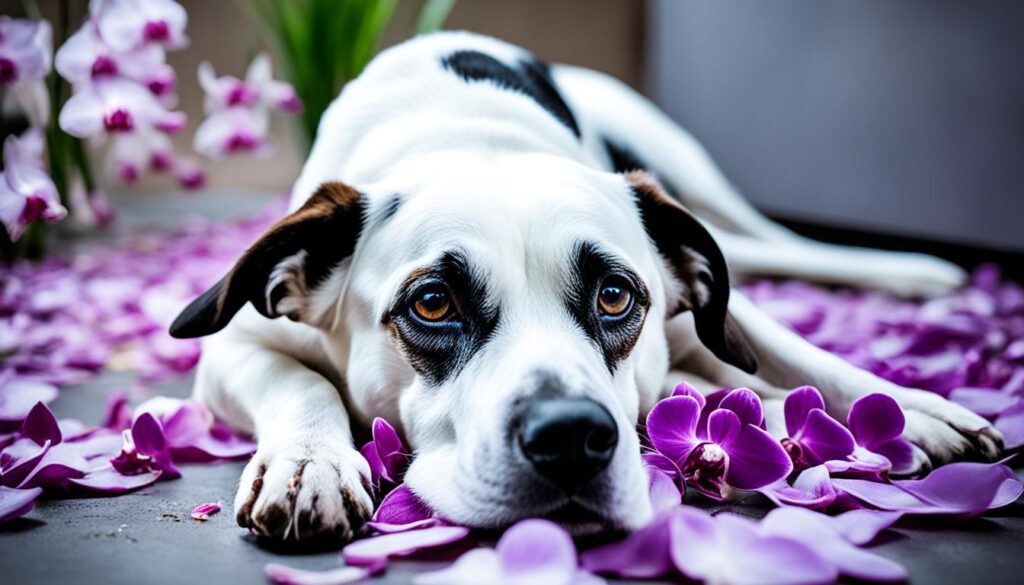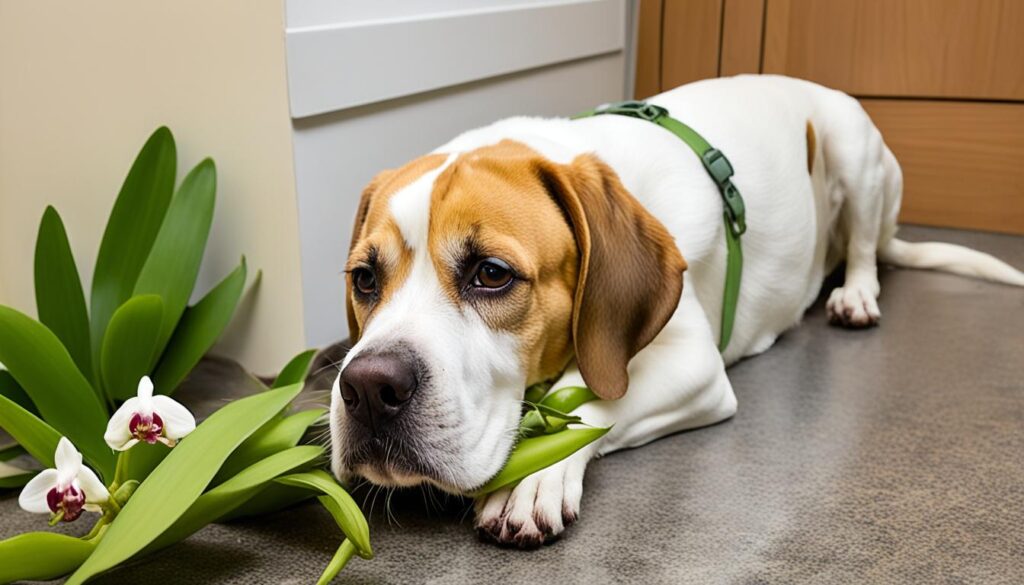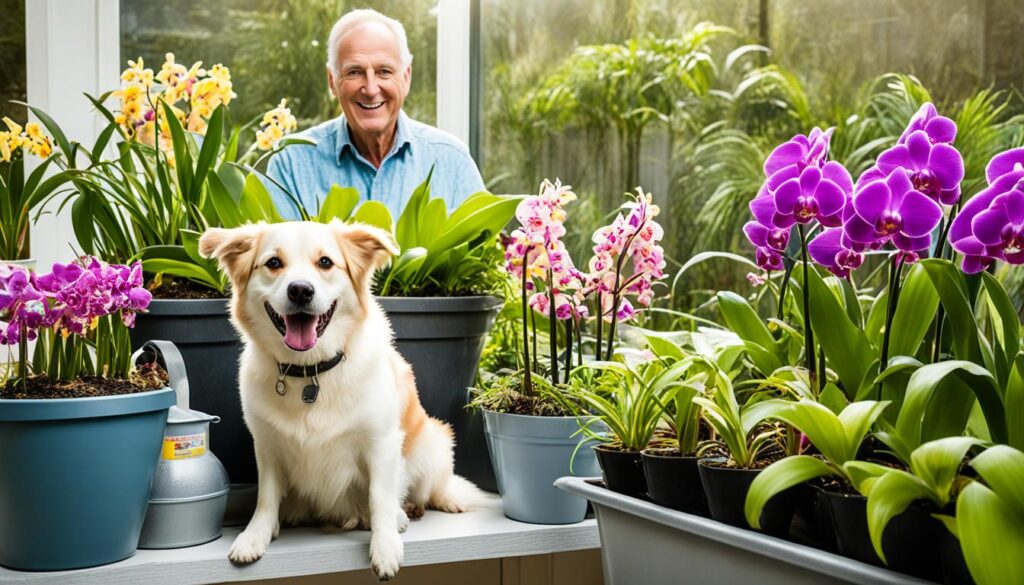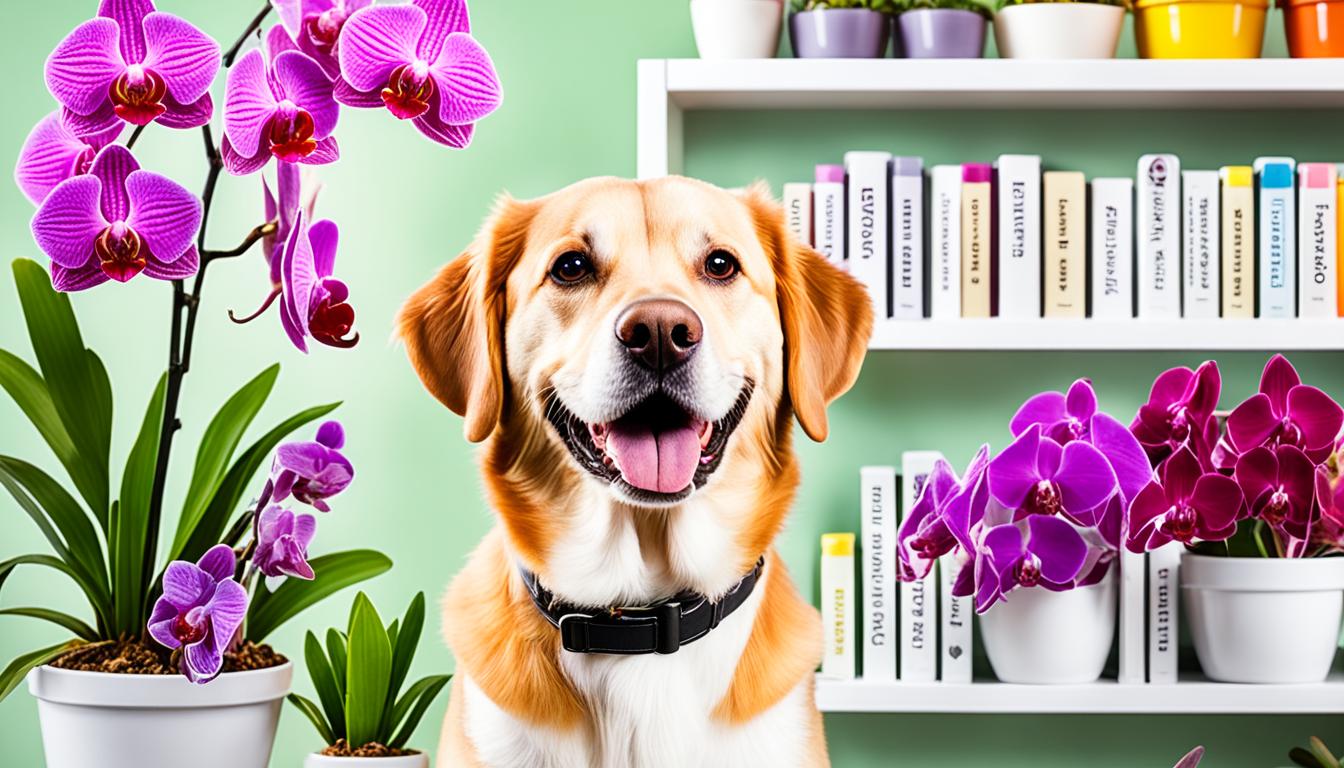Orchids are generally seen as a pet-safe plant, but there are some other considerations you may not have thought about…..
As an avid dog lover and a plant enthusiast, I’m armed with insights from the American Society for the Prevention of Cruelty to Animals (ASPCA), which confirms that orchids from the Orchidaceae family are non-toxic to our canine companions.
However, dog owners should still be vigilant when their furry friends are around these plants as the effects of orchids on dogs can vary, particularly if they ingest the wrong species or potting additives.
While my pups may be more interested in their toys than my collection of orchids, it’s essential for fellow dog owners to know which species are pet-safe orchids and which should be kept far from curious snouts.
For example, the Brazilian Orchid and Phalaenopsis Orchid are safe additions to a dog-friendly household, yet due diligence is always recommended, especially when dealing with plant fertilizers or unusual varieties such as dyed flowers.
My commitment is to maintain a safe, vibrant living space for all my family members, both two-legged and four-legged, ensuring that all my houseplants, including orchids, pose no threat to my beloved pets.
Key Takeaways
- Most orchids, including the Phalaenopsis and Brazilian varieties, are considered orchid plants safe for pets.
- Potting mix additives, such as those containing redwood, could pose risks to dogs and should be checked.
- While generally non-toxic, certain orchid species and processed products like dyes can have adverse effects on dogs.
- It’s crucial to keep potentially toxic plants like the Lady Slipper Orchid away from dogs.
- Creating a pet-safe environment means ensuring your floral displays are secure and out of paws’ reach.
- Stay informed with lists from trusted organizations like the ASPCA when selecting houseplants.
Understanding Orchids: A Brief Overview
As someone who both adores their canine companions and cherishes the serene beauty of exotic flora, I’ve come to appreciate the harmony that certain orchid plants can bring into a pet-inclusive home.
My fascination with these enchanting plants has led me to explore various varieties known for being safe for our furry friends.
Key Features and Varieties of Orchids
When scouting for dog-friendly orchids, I discovered a handful of species that are celebrated not just for their aesthetic appeal but also for their safety around pets.
Among these are the vibrant Phalaenopsis Orchid and dazzling Oncidium hybrids, both commonly known as pet-safe choices.
Let us take a visual tour through a curated list of orchids that are widely recognized as non-toxic to dogs.
| Orchid Variety | Description | Pet-Friendly Status |
|---|---|---|
| Phalaenopsis Orchid (Moth Orchid) | Known for its broad, fluttery blooms that resemble moths in flight | Safe for Pets |
| Brazilian Orchid | A tropical species that flourishes with minimal care, ideal for busy pet parents | Safe for Pets |
| Oncidium (Dancing Lady) | Distinctive for its sprays of miniature flowers likened to twirling dancers | Safe for Pets |
| Crimson Cattleya | Boasts remarkable, large flowers in deep shades of crimson | Safe for Pets |
| Leopard Orchid | Exclusive for their speckled patterns, resembling the coat of a leopard | Safe for Pets |
It is paramount to note that while these varieties of orchids are deemed safe for pets, vigilance is still advised. Certain species, such as the Lady Slipper Orchid, can cause health concerns for dogs and should be avoided.
Always prioritize the well-being of all household members, both two-legged and four-pawed, by selecting orchid plants safe for pets.
My commitment to creating a pet-friendly environment is reflected in my careful selection of Oncidium and Phalaenopsis varieties, ensuring peace of mind for pet owners like myself who wish to adorn their space with these stunning blossoms.
The Relationship Between Orchids and Dogs
Many pet owners who cherish both their furry friends and their floral collections often worry about the potential toxicity of plants.
When discussing the safety of orchids around dogs, it’s a relief to note that most of these elegant plants pose no severe risk.
However, as a responsible pet owner, I must be aware of certain orchids and orchid-related products that could cause harm to my dog.
Common Concerns: Toxicity and Dog Safety
On the whole, orchids are not classified as poisonous to dogs. Most varieties of this beautiful plant, including the popular Phalaenopsis orchids, are deemed safe for our canine companions.
Despite this, one cannot ignore the ongoing concerns about orchid risks for dogs.
Certain plants may carry orchid poisoning in dogs due to exposure to chemicals or other non-plant materials.

Specific Orchids to Watch Out For: The Lady Slipper Orchid
The Lady Slipper Orchid is one variety that requires a bit more caution. Though not deadly, they can be mildly toxic to dogs, potentially leading to gastrointestinal discomfort if ingested.
Thus, identifying and avoiding the placement of such orchids within the reach of my pet is a crucial step in ensuring their safety.
Potential Hazards: Bark, Compost, and Pot Considerations
Orchid enthusiasts often use specialized potting mixes such as materials including bark and compost, which may be harmless to plants but not always benign to canine health.
For instance, some bark mixes contain redwood, known to cause complications if ingested by dogs.
It’s important to assess and understand the content of potting mixes used within my home, as they can be a hidden source of orchid risks for dogs.
The Risk of Fertilizer and Pesticide Ingestion
Maintaining lush, healthy orchids typically involves fertilizers and pesticides, chemicals that are potentially harmful if my dog decides to have a taste.
The ingestion of these substances could result in a range of symptoms from mild to severe, depending on the quantity and type of chemical consumed.
Here, prevention is key, ensuring these substances are out of my dog’s reach will help minimize any potential risk of orchid poisoning in dogs.
By being vigilant about the possible orchid risks for dogs and taking simple preventive measures, I can safely enjoy the dual joy of having both my beloved dog and beautiful orchids coexist under one roof.
Immediate Actions: If Your Dog Eats an Orchid
As a pet owner, I know the concern that surges up when our furry companions get into things they shouldn’t.
Discovering that your dog has nibbled on an orchid can certainly be one of those worrisome moments.
“Can dogs eat orchids?” is a question that strikes fear into pet owners’ hearts, but it’s crucial to stay calm and act quickly.
First Steps to Take: Removing the Plant and Monitoring
The initial step is clear: ensure that all parts of the orchid are out of your dog’s reach to prevent any further consumption.
Observing your dog’s behavior after the incident is vital to promptly identify any adverse effects of orchids on dogs.
While orchid toxicity in dogs is generally low, it’s better to watch for any changes in their demeanor or appetite that could indicate discomfort.
Identifying Signs of Distress: Skin Allergies and Symptoms
If your dog has eaten an orchid, they may experience skin allergies or gastrointestinal symptoms like vomiting or diarrhea.
These symptoms occur rarely, given that most orchids aren’t poisonous to dogs, but reactions can vary depending on individual sensitivities and the orchid species.
The Importance of Veterinary Consultation
Any sign of distress warrants an immediate consultation with your veterinarian.
The orchid your dog ingested may have been treated with pesticides or dyes, which could lead to different medical concerns.
A professional assessment by a vet is essential to rule out any serious health issues.
Adhering to Veterinary Advice and Care
After speaking with the vet, you must adhere to their advice.
Whether it’s a simple home observation or a more thorough medical intervention, following guidelines provided by your vet is crucial for your dog’s health and safety.
It is the best course of action to mitigate the risks related to orchids and dogs.

Health Implications: Understanding the Risks
As a responsible pet owner, my concern for the well-being of my dog extends to every aspect of their environment, including the plants within reach.
While the consensus is that orchids are not toxic to canines, it’s crucial to delve deeper and comprehend potential health implications, particularly concerning the question, “Are orchids poisonous to dogs?”
Digestive and Health Concerns Post-Ingestion
In the event that a dog ingests part of an orchid, especially one possibly treated with dyes or paired with hazardous potting materials, the dog may experience digestive upset.
Symptoms like vomiting and diarrhea are clear indicators of orchid poisoning in dogs and require close monitoring.
Circumstances can vary, and while some dogs might only have a brief period of discomfort, others could face more serious gastrointestinal distress.
It’s essential to observe your pet for any changes in appetite, behavior, or bowel movements following such incidents.

Long-Term Safety: Will My Dog Be Okay?
Fortunately, the prognosis for dogs who have ingested parts of orchid plants is mostly reassuring.
Fast-tracked recovery is common when no toxic varieties or significant quantities of harmful substances have been consumed.
However, continued vigilance is key; maintaining a list of dog-friendly orchids and supervising pets around houseplants remain top priorities.
Preventative measures are undoubtedly the most effective means to eschew adverse health effects and ensure the safety and happiness of our furry friends within the floral ambiance of our homes.
Preventative Measures: Keeping Dogs Safe
As a devoted pet owner and plant enthusiast, I’ve found that safeguarding our pets is as essential as nurturing our plants.
Ensuring that orchid plants are safe for pets requires thoughtful strategies that combine pet behavior understanding with practical home adjustments.
Let’s explore effective measures to keep pets safe around these beautiful floral additions.
Strategies to Prevent Orchid and Plant Ingestion
Creating a pet-safe environment for our furry friends doesn’t just happen—it requires deliberate actions and consistent vigilance.
Here are some of the strategies I recommend to minimize the risks and keep our spaces conducive for both pets and plant life:
- Restrict Access: Place orchids on higher shelves or hanging planters where curious canines cannot reach them.
- Deterrents: Use pet-safe bitter sprays on the foliage to discourage dogs from taking an unhealthy interest in your orchids.
- Educational Resources: Familiarize yourself with a reliable list of pet-safe orchids, such as the one provided by the ASPCA, and cross-check plants before purchase or display.
- Surveillance: Supervise your pets when they are in an area with plants. A moment of monitoring can prevent a potential mishap.
- Physical Barriers: Install baby gates or decorative fences as buffer zones to create a clear boundary between your pets and your plants.
These efforts are designed to promote an atmosphere where the allure of orchids can be enjoyed without risking the welfare of our cherished pets.
| Preventative Action | Description | Benefits |
|---|---|---|
| Elevating Plants | Keeping plants out of reach from pets | Reduces the chance of ingestion |
| Bitter Spray | Applying taste deterrents on plants | Discourages licking and chewing |
| Educational Resources | Checking plant safety against resources | Ensures pet-safe plant selection |
| Pet Supervision | Watching pets near plants | Immediate intervention if needed |
| Physical Barriers | Setting up gates or fences around plants | Creates a safe space for both pets and plants |

Incorporating these pet-safe strategies, especially for dog owners, not only keeps our orchid plants safe for pets but also cultivates a harmonious living space.
By exercising these precautions, we can cherish the beauty of our pet-safe orchids without worry, embracing a habitat where flora and fauna thrive together.
Dispelling Myths: The Truth About Orchids and Dogs
As a dog owner and plant enthusiast, I feel it’s my duty to unravel the misconceptions that often lead to unnecessary worries.
Let’s delve into the reality of orchids and their interaction with our canine friends. By confronting and debunking orchid myths, we pave the way for a stress-free coexistence between our pets and these lovely plants.
Specifically, we’ll take a closer look at the supposed orchid toxicity in dogs, explore the origins of these myths, and enlighten ourselves on the factual aspects of orchids as non-toxic plants for pets.
Addressing the Toxic Orchid Myth
It’s a common narrative that all orchids are harmful to dogs, but this couldn’t be further from the truth.
In reality, varieties such as the Oncidium and Phalaenopsis are entirely non-toxic orchids for pets. The broad label of orchid toxicity in dogs is unjustified and misleading.
While few species can cause mild stomach upset, the majority of orchid species pose no significant risk.
Through education and awareness, we can uphold the safety of our pets, all while embracing the natural beauty of orchids in our homes.
Investigating the Threat of Blue Orchids
Blue orchids, with their stunning hue, often attract attention and skepticism about their safety.
Some believe that the dye used to create their color is harmful, yet there’s no evidence to suggest that such dyes are toxic to dogs.
However, it’s always prudent to monitor any artificial treatments on plants and their potential effects.
Transparency in horticulture practices plays a vital role in ensuring that the plants we introduce into our home environment are orchid plants safe for pets.
Clarifying Misconceptions About Orchid Potting Mix
Another area muddled with misconceptions is orchid potting mixes. Some assume that these substrates are hazardous, leading to the false sentiment that are orchids poisonous to dogs.
While it’s true that you should be mindful of additives like certain fertilizers and chemicals, most commercial orchid mixes are safe.
It’s crucial to verify the ingredients of any potting mix and opt for organic, pet-friendly options when available.
Non-Toxicity vs. Non-Reactivity: Understanding the Difference
A vital distinction that needs highlighting is between non-toxicity and non-reactivity.
Although orchids are not poisonous, dogs might react by experiencing mild gastrointestinal issues if they ingest non-edible items, including plants.
This reaction doesn’t necessarily correlate with toxicity. It’s about their digestive system responding to unfamiliar materials, which is why dog-proofing your green space for safety is essential.
Dog-Proofing Your Green Space for Safety
Creating a safe environment for dogs involves more than just choosing the right plants. It is an ongoing process of making your green space a secure area where dogs can explore without risk.
Implementing practical steps such as keeping orchids out of reach, possibly using plant stands or hanging baskets, considerably reduces the prospect of any potential issues.
Recognizing When to Seek Veterinary Help
In the rare instance where your dog displays adverse reactions after nibbling on an orchid, knowing when to seek veterinary help is imperative.
Timely assistance can alleviate minor symptoms before they escalate. Always keep a close eye on any out-of-the-ordinary behavior in your pets following such incidents.
Debunking Common Myths and Misinformation
My objective here is to provide clarity amidst a sea of misinformation regarding orchids and dogs.
By upholding evidence-based knowledge, I aim to reassure fellow pet owners that, yes, are orchid plants safe for pets?
Absolutely, as long as we choose the right species and maintain an environment mindful of our dogs’ nature to explore.
Safety, Edibility, and Behavioral Queries
The safety of our pets is of utmost importance, and when it comes to edibility, the general rule of thumb is to avoid allowing dogs to ingest plants.
Behavioral tendencies can influence how dogs interact with plants, so close supervision and training are beneficial.
The more we understand about our pets and their habits, the better we can cater to a safe and engaging home for them.
Insights on Dog-Friendly Orchids and Plant-Eating Habits
As we wrap up this discussion, I encourage dog owners to research and choose dog-friendly orchids, continue to learn about their pets’ plant-eating habits, and actively work towards debunking myths about whether are orchids poisonous to dogs.
By doing so, both your pet and your orchids can flourish in harmony within the same household. Knowledge empowers us to maintain a delightful and secure environment for all our loved ones, furry ones included.
FAQ
Are orchids poisonous to dogs?
No, orchids are not considered toxic to dogs. The American Society for the Prevention of Cruelty to Animals (ASPCA) lists orchids as non-toxic to dogs. Varieties such as the Brazilian Orchid, Easter Cattleya, Leopard Orchid, and Phalaenopsis Orchid are safe for canine companions.
What are some dog-friendly orchid varieties?
Some dog-friendly orchid varieties include Phalaenopsis Orchid, Brazilian Orchid, Crimson Cattleya, Easter Cattleya, and Leopard Orchid. These orchids are among those listed as non-toxic to dogs by the ASPCA and are commonly found in homes and gardens without posing a risk to pets.
Can the potting material for orchids be harmful to dogs?
Yes, while the orchids themselves are not toxic, the potting material may contain additives such as pesticides, fertilizers, or other substances like pine bark or redwood, which can be harmful if ingested by dogs. It is important to keep the potting mix out of reach or to use pet-friendly alternatives.
What should I do if my dog eats an orchid?
If you find your dog has eaten an orchid, remove any leftover plant material and monitor your pet closely for any symptoms of distress such as vomiting or diarrhea. Although orchids are non-toxic, ingestion can still result in gastrointestinal upset. If you notice any concerning signs, consult your veterinarian promptly.
Are there orchid-related risks for dogs other than the plants themselves?
Yes, besides the plant itself, there can be risks related to fertilizers, pesticides, and certain potting materials used with orchids. These substances can be harmful if ingested by dogs. Additionally, orchids treated with dyes or chemicals may pose a risk. Always ensure that your dog does not have access to these potential hazards.
Are there any specific orchids that are toxic to dogs?
While most orchids are not toxic to dogs, there are varieties that might pose a threat, such as the Lady Slipper Orchid. It’s a good practice to identify the specific type of orchid and verify its safety before bringing it home to a household with dogs.
What are the signs of potential orchid poisoning in dogs?
While orchid poisoning is rare since orchids are generally non-toxic, ingestion of harmful additives in potting material or orchids treated with chemicals can cause signs such as skin allergies, vomiting, diarrhea, agitation, or dehydration. If you suspect your dog has been poisoned, seek veterinary care as soon as possible.
How can I keep my dog safe around orchids?
To ensure your dog’s safety around orchids, consider placing the plants out of reach, using barriers or deterrents to prevent chewing, and supervising your pet near the plants. Also, be aware of the types of orchids and orchid-related materials that may pose a risk to your pet.
What should I know about the blue orchids and dogs?
Blue orchids are often achieved through dyeing, and while the orchid itself is non-toxic, the dye can be harmful if ingested by dogs. It’s best to avoid bringing dyed orchids into a home with dogs, or to ensure they are kept out of your pet’s reach.
How can I dog-proof my green space to include orchids safely?
Dog-proofing your green space involves choosing dog-friendly plant varieties, keeping potentially hazardous materials out of reach, using pet-safe pesticides and fertilizers if needed, and possibly creating designated plant-free zones for your dog to enjoy without the risk of ingesting harmful plants or substances.


Leave a Reply